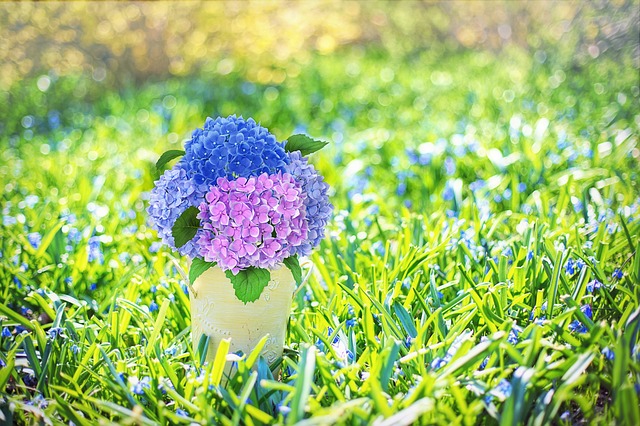Hydrangeas are one of the favorite plants to brighten gardens, since they usually give off a colorful flower that is grouped with others at the tips of the branches, giving a large and very pretty image.
Depending on the pH of the soil, the flower will be blue, pink or white. This color can be achieved in a directed way by the farmer, fertilizing the soil in which the plant is planted with fertilizers that contain the necessary mixture to achieve the desired color.
Great variety of colors and species
There are more than 100 species of hydrangeas throughout the world, their use is generally ornamental and most are native to Asia.
The most common is to find them in bushes from one to three meters maximum, but there are varieties that grow in the form of vines or small trees.
In the Asian continent they take advantage of the anti-inflammatory and diuretic properties of the root of the plant for medicinal purposes.
Beautiful flower
The hydrangea as an ornament is appreciated for being easy to propagate, beautiful to look at, with a pleasant aroma and simple care, which makes it suitable for being kept in any Mediterranean climate garden, as long as care is taken to keep the plant well hydrated. And paid.
One of the main cares to achieve a healthy and flowering hydrangea plant is to carry out the proper pruning of its leaves and stems. Pruning must be done following certain guidelines and at certain times of the year, depending on the desired results.
It is a fact that pruning is used to give the necessary shape required of a bush or tree, or for artistic reasons.
However, in the case of blue hydrangeas, pruning is extremely important for the health of the plant, since if it is allowed to grow without limits, its branches will not be able to be sustained and will break under their own weight, irreparably damaging themselves.
What do you need:
- Pruning Shears. They are those that have a cutting blade and another without an edge and their shape is hooked. Good and useful pruning shears will be those that have a homogeneous cut, firm that resist the hard load of work without disassembling, with a solid grip and preferably that have a spring mechanism that facilitates the task with less effort.
- In the case of pruning hydrangeas, it is preferable to have pruning shears with long handles, as this will make it easier to access the base of the branches without running the risk of accidents.
- Fertilizer for hydrangeas.
- Bluing agent or mix of substrates if it is intended to direct the color of the flowers of the hydrangea plant.
Instructions: When is it appropriate to prune?
It is very important to take into account the time of year in which the hydrangea is to be pruned. The ideal is to wait until the end of winter if it has not been very harsh, or wait until the beginning or middle of spring.
This is because the withered flowers serve as protection against frost for the branches on whose tips they are held.
Types of hydrangea wood
Prior to pruning the hydrangea plant, it is necessary to identify the types of wood or stems that the hydrangea plant has, since the cuts to be made will depend on this to avoid removing excess branches, affecting future flowering.
Branches or old wood are, as their name indicates, the branches that we can see already quite dry, hard, that will not give flowers again.
Branches, or three-year-old wood, are the mature branches that are likely to flower the following season and are easily identified because they are usually where the previous season’s faded flowers are found. Suckers are strong, thick, new branches that come out very close to the base of the plant.
Pruning
The first thing to do is identify the branches or old wood, those that are already woody. These branches should be cut from the base, at a height of one centimeter from its bud (the thick part where the branch is born from the trunk).
These branches will no longer bear flowers and are therefore a burden to the plant.
It is important to pay special attention to the center of the plant, since it is the place where the oldest wood accumulates, forming bundles of crisscrossed aged branches that become difficult to prune if left too long.
Although most of the old stems should be cut, it should be verified that those that serve as support for the plant are not affected by pruning. Hydrangea flowers are usually heavy and if we cut too much, the plant could collapse under their weight.
Three – year-old branches or wood should be pruned towards the middle of the branches that have been produced, generally there are two, always preferring to eliminate the oldest or those that have flowered the previous season when cutting.
As a general rule, some suckers are respected at the time of pruning, since many new flowers will appear at their tip, however, only those that do not have an excessively thick or long stem should be left, since it will absorb too many nutrients and may weaken the rest of the plant.
In addition to these indications, dry, damaged, crooked, broken flowers and branches or whose appearance justifies the suspicion of a pest or disease should always be removed from the hydrangea plant.
Before finishing, you can take advantage of the functional pruning of the plant to complement it with an aesthetic pruning and thus give the shape and size that you prefer for the decoration of the garden.
Finishing the pruning, it is very convenient to feed the plant by adding compost or fertilizer to the soil and if you want to manipulate the color of flowering, add the appropriate mix of substrates and proceed to water the soil abundantly to homogeneously incorporate the added elements.


















